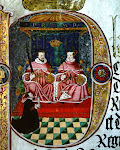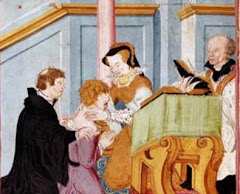
Traditionally Edward VI’s ‘devise’ for the succession which deprived Mary and Elizabeth of the throne primarily on grounds of their illegitimacy and granted the kingdom to Jane, has been regarded as unlawful. The typical approach taken on this issue can be found in David Loades, Mary Tudor: The Tragical history of the first queen of England (2006), when he states:
‘Not only was parliamentary consent required for the change that he [Edward] was proposing, but as a minor he was not even capable of making a valid will. As the days ticked by Northumberland became increasingly desperate, even threatening violence against the obstructers. Eventually it was agreed that the only way to proceed was by letters patent, which would have to be retrospectively confirmed. Such letters were drawn up, but they never passed the seals, and thus were never properly validated, and so remained technically invalid.’ [2]
In such a narrative the actions of Edward, the duke of Northumberland and the conspirators remains highly dubious. Since Mary’s right to succeed was confirmed in a parliamentary statue (the Act of Succession of 1544, 35 Hen. VIII, c. 1), then the same administrative body was expected to be endorsed in the occasion that the monarch wished to remove Mary from the succession. Could the 1544 act be overturned just by Edward VI’s will? Or did parliament need to be included in all this?
In an article on Tudor dynastic problems, Eric Ives noted that Edward ‘was clearly copying his father’.[3] Many know of Henry VIII’s obsession with the succession that resulted in a string of marriages, and three separate parliamentary statutes explicitly concerning this subject. Cleary Henry believed that the monarch held the right to decide who his heirs should be and implement parliament to confirm this. His belief in the crown’s prerogative in matters of the succession went even further. The 1544 Act stated that the king ‘myght by the auctoritie of the saide acte give and dispose the ... crown ... by his letters patentes ... or by his last will ... to any person or persons’.[4] In other words if Henry, after endorsing parliament to confirm the succession, wished to subsequently change his heirs he had the power to make such an amendment by letters patent or in his will. In the end Henry chose to confirm the details of the 1544 act in his final will by stating again that all three of his children had a place in the succession. But he still held the power to state otherwise if he wished.

Edward's 'devise for the succession', 1553. Notice the change made on line four - after 'L Jane', Edward has inserted 'and her' so the line reads 'L Jane and her heires masles' instead of just 'L Jane heires masles'.
Although Edward laid out his succession in the ‘devise’ (which had to be modified because the first draft left the crown to Jane's ‘heirs masles’ and not actually to Jane herself), he did use letters patent to support such changes. Loades states that they were ‘never properly validated’, and certainly Edward came across opposition to his actions.[5] Nonetheless the letters patent were signed by many prominent figures in government, by judges and certain leading citizens of London.[6] But does this mean that Edward’s actions were entirely legal and that he reserved the right to change the succession purely because he was the monarch?
To argue that Edward did have the right to remove Mary and make Jane his heir is to infer that the 1544 act which allowed Henry to change his mind was a privilege that extended to subsequent monarchs. But when Henry oversaw the passing of the 1544 act did he ever intend for the clause that the monarch ‘myght by the auctoritie of the saide acte give and dispose the ... crown ... by his letters patentes ... or by his last will ... to any person or persons’ to be a power for all future kings (or queens) of England ? Or was he just concerned with himself?
Then there is another problem. Was Edward of a suitable age to make such actions? In 1544 Henry was a monarch in his fifties, who had exercised power for over thirty years. There was no outcry when he had this act passed. But Edward, though highly precocious for his age and concerned with administrative and particularly religious affairs, was only fifteen years old by the spring of 1553 and the country still had a lord president and a council that governed for him. When attempting to avoid conforming to the religious policies of her brother’s reign, Mary asserted that she would not recognise the laws owing to her brother’s tender age. For Mary, Edward’s policies were actually his councillors and she would not comply until he came of age to decide for himself. But her argument was not necessarily shared by all, and maybe Mary did not entirely endorse it. After all, Mary’s protests were all part of her attempts to avoid changing her own religious practise and to resist adopting the new policies which she regarded as heretical. It was therefore pragmatic to argue that these new laws were not legitimate and subsequently she should carry on endorsing the religious practise of her father’s reign. But many others did not show such defiance. Its notable how one contemporary judge, Edward Montagu, claimed that he had been troubled by the fact that Edward’s ‘devise’ conflicted with an act of parliament but Montagu did not state that he felt Edward was wrong in enforcing his royal will.[7] Rather, the judge argued, there were legal niceties that needed to be observed in order for Edward to go about appointing his own successors and in this circumstance they were not met. But even Montagu agreed to Edward’s changes in the end.
 This post is full of questions and provides few answers. This ambiguity is caused by the fact that work on this subject is forthcoming and until publication it is hard to establish a definite position. The work in question is Eric Ives, Jane Grey: A Tudor Mystery (WileyBlackwell, Oct 2009) that is to propose that Jane had strong legal grounds for her succession. Whilst scouring the internet for any information about this study I came across the book’s table of contents. One chapter is entitled ‘The rebellion of Mary Tudor’ and relates to Mary’s accession and Jane’s downfall. It is certainly an interesting way of looking at this subject. Was Mary the rebel who overthrew Jane the queen?
This post is full of questions and provides few answers. This ambiguity is caused by the fact that work on this subject is forthcoming and until publication it is hard to establish a definite position. The work in question is Eric Ives, Jane Grey: A Tudor Mystery (WileyBlackwell, Oct 2009) that is to propose that Jane had strong legal grounds for her succession. Whilst scouring the internet for any information about this study I came across the book’s table of contents. One chapter is entitled ‘The rebellion of Mary Tudor’ and relates to Mary’s accession and Jane’s downfall. It is certainly an interesting way of looking at this subject. Was Mary the rebel who overthrew Jane the queen? Admittedly I have always perceived matters the other way around. Jane the imposter, Mary the rightful claimant. And I still question whether Edward’s actions can be regarded as legal owing to the absence of parliament in all this. Edward could of course not help the fact that his heath was rapidly declining and that he did not have the time to call parliament immediately to verify his changes. There is evidence, as Ives points out, that Montagu urged for a parliament to convene in September 1553 to authorise Edward’s actions which does indicate the importance placed upon using parliament to overturn the 1544 act and remove Mary’s right to succeed.[8] Nonetheless Ives’s future work raises interesting questions about the royal prerogative and whether Henry set a precedent for his heir to decide outside of parliament how the succession was to be determined.
~~~~~~~~~~~~~~~~~~~~~~~~~
[1] The diary of Henry Machyn, citizen and merchant-taylor of London, from AD 1550 to AD 1563, ed. J. G. Nichols, CS, 42 (1848), cited from David Loades, The Chronicles of the Tudor Queens (Gloucestershire, 2002), p. 5.
[2] David Loades, Mary Tudor: The Tragical history of the first queen of England (The National Archives, 2006), p. 97.
[3] Eric Ives, ‘Tudor dynastic problems revisited’, Historical Research, 81, 212 (May 2008), p. 268.
[4] Extract from 35 Hen. VIII, c. 1), cited in Ives, ‘Tudor dynastic problems revisited’, p. 265.
[5] According to contemporary chronicler Robert Wingfield, two lawyers (John Hales, the justice of the common pleas and John Gosnold, solicitor general), opposed the scheme.
[6] Jennifer Loach, Edward VI (New Haven and London, 1999), p. 165.
[7] Ives, ‘Tudor dynastic problems revisited’, p. 269-70.
[8] Ives, ‘Tudor dynastic problems revisited’, p. 270.




A intriguing problem. Thank you.
ReplyDeleteThank you! I look forward to reading Ives's whole argument (which hopefully will encourage numerous responses).
ReplyDeleteMy own book on Lady Jane Grey and her sisters, which is out this month in the US, argues that Jane's active opposition to Mary continued until her death, best wishes, Leanda de Lisle (author of The Sisters Who Would be Queen)
ReplyDeleteThank you for your post! I'm sorry for the late response; unfortunately I receive no emails telling me when someone posts here so I often overlook comments. I look forward to reading your book; it was one I requested for my birthday so I have to wait about two months to get it! I have just read Ives’s work on Jane and look forward to reading your own arguments. Ives’s work focuses primarily on the events of July 1553, thus I would be interested in reading further about the fate of the other two Grey sisters. The only reading so far I have done on them is their respective Oxford DNB articles which are rather limited.
ReplyDeleteMany thanks for commenting on my blog!
I very much hope you enjoy my book. I differ with Ives on various points, but have huge respect for him. About half my book is dedicated to the younger Grey sisters, whose stories are, I think, very romantic ones. Interestingly opinion is spilt of which is the better half of the book!, best wishes, Leanda
ReplyDelete